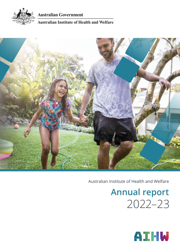CEO's report
Mr Rob Heferen
It was another busy and productive year for the institute as we further strengthened our role as a national leader in health and welfare data. 
We continued to deliver on our vision for stronger evidence, better decisions, and improved health and welfare under the governance of the AIHW Board.
I would like to take this opportunity to welcome The Hon Nicola Roxon in the AIHW Board Chair role this year. I look forward to working with Ms Roxon to provide a stronger evidence base to inform policies, programs, research and development. I extend my thanks to former board chair Louise Markus and former member Simone Scovell for their strategic guidance throughout their tenure. I also thank Erin Lalor for her leadership during the year as acting Board Chair.
This year we continued to see increasing demand for health and welfare data and analysis as we moved out of the peak of the pandemic. In 2022–23, we released more than 400 data products – an increase of more than 35% on last year. It would not be possible to meet this demand without the trust and cooperation of our many data custodians, the vast majority of whom are in state and territory government departments, and the dedication and commitment of our people.
This year, our workforce underwent a significant transformation as more than 130 labour-hire contractors transitioned into ongoing and non-ongoing APS roles, leading to greater workforce stability. Throughout this transition staff continue to be highly engaged in the work that we do, evidenced by strong results in the 2023 APS Employee Census.
I acknowledge many of the data assets we manage contain sensitive data and it’s crucial that we maintain rigorous controls to protect personal data and safeguard privacy. This year we have continued to strengthen our approach to data governance and ICT security to meet these challenges.
We continue to improve our data linkage capabilities to make it easier for researchers to access linked data through our linked data assets. We also continue to work in collaboration with the Department of Social Services and Australian Bureau of Statistics on the National Disability Data Asset, which will bring together data about people with disability to give a more complete picture of disability in Australia. It will also assist decision makers in their quest to improve the lives of people with disability.
Another focus was making our data and information accessible by ensuring it is delivered to the right people, at the right time, and in the right way. Accessible data is essential in ensuring we have a real and measurable impact, and the Australian Disability Strategy Outcomes Framework website is just one example of how we’re delivering our data to the people who really need it. This highly accessible website provides everyone – from people living with disability and their carers to policymakers across all levels of governments – with a shared understanding of progress against Australia’s Disability Strategy 2021–2031.
In July 2022, we released Australia’s two-yearly health report card – Australia’s health 2022. Australia’s health 2022 brings together multiple data sources to provide a holistic view of the health of Australians. It explored topical health issues including factors that influence our health, mental health and changes to mortality over the past 100 years.
We also launched the Mental Health Services Activity Monitoring System (MH SAMS), providing a more efficient way to share and present insights about how Australians were accessing mental health services during, and after, the pandemic.
We will continue to strengthen our partnerships and mature our capabilities to ensure we can continue to meet Australia’s health and welfare data needs, both now and in the future.



